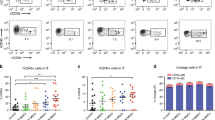Abstract
Recent studies have clearly identified that hematopoietic stem cells (HSC) are part of a hierarchical organization defined by cells able to initiate long-term repopulation (LT-HSC) of injured BM followed by populations with transient repopulation ability. As HSCs are able to supply blood cells for the lifespan of the individual, LT-HSCs undergo an aging process. The consequences of aging are an increase in the stem cell pool size, increased self-renewal and production of cells with expression of myeloid-specific genes and genes commonly expressed in myeloid leukemia. The age-related increased incidence of myeloproliferative disorders is therefore not surprising. Marrow cells circulate and migrate to a number of different organs. Previously assumed tissue and organ specificities appear to be less stringent and primitive cells residing in one organ may contribute to the structural and functional regeneration of other organs. It is intriguing to speculate that cells and cytokines used in appropriate concentrations may be able to repair damaged organs by using the defective organ as a scaffold, thus reducing the need for the transplantation of solid organs.
This is a preview of subscription content, access via your institution
Access options
Subscribe to this journal
Receive 12 print issues and online access
$259.00 per year
only $21.58 per issue
Buy this article
- Purchase on SpringerLink
- Instant access to full article PDF
Prices may be subject to local taxes which are calculated during checkout
Similar content being viewed by others
References
Till JE, McCulloch EA . A direct measurement of the radiation sensitivity of normal mouse bone marrow cells. Radiat Research 1961; 14: 213–222.
Rossi DJ, Bryder D, Weissman IL . Hematopoietic stem cell aging: mechanism and consequence. Exp Gerontol 2007; 42: 385–390.
Manfredini R, Zini R, Salati S, Siena M, Tenedini E, Tagliafico E et al. The kinetic status of hematopoietic stem cell subpopulations underlies a differential expression of genes involved in self-renewal, commitment, and engraftment. Stem Cells 2005; 23: 496–506.
Kamminga LM, De Hann G . Cellular memory and hematopoietic stem cell aging. Stem Cells Aging 2006; 24: 1143–1149.
Lapidot T, Kollet O . The essential roles of the chemokine SDF-1 and its receptor CXCR4 in human stem cell homing and repopulation of transplanted immune-deficient NOD/SCID and NOD/SCID/B2m(null) mice. Leukemia 2002; 16: 1992–2003.
Dar A, Kollet O, Lapidot T . Mutual, reciprocal SDF-1/CXCR4 interactions between hematopoietic and bone marrow stromal cells regulate human stem cell migration and development in NOD/SCID chimeric mice. Exp Hematol 2006; 34: 967–975.
Nilsson SK, Simmons PJ, Bertoncello I . Hemopoietic stem cell engraftment. Exp Hematol 2006; 34: 123–129.
Dar A, Kollet O, Lapidot T . Mutual reciprocal SDF-1/CXCR4 interactions between hematopoietic and bone marrow stromal cells regulate human stem cell migration and development in NOD/SCID chimeric mice. Exp Hematol 2006; 34: 967–975.
Kucia M, Reca R, Miekus K, Wanzeck J, Wojakowski W, Janowska-Wieczorek A et al. Trafficking of normal stem cells and metastasis of cancer stem cells involve similar mechanisms: pivotal role of the SDF-1-CXCR4 axis. Stem Cells 2005; 23: 879–894.
Shi M, Li J, Liao L, Chen B, Li B, Chen L et al. Regulation of CXCR4 expression in human mesenchymal stem cells by cytokine treatment: role in homing efficiency in NOD/SCID mice. Haematologica 2007; 92: 897–904.
Lang D, Powell SK, Plummer RS, Young KP, Ruggeri BA . PAX genes: roles in development, pathophysiology, and cancer. Biochem Pharmacol 2007; 73: 1–14.
Souabni A, Jochum W, Busslinger M . Oncogenic role of Pax5 in the T-lymphoid lineage upon ectopic expression from the immunoglobulin heavy-chain locus. Blood 2007; 109: 281–289.
Retz MM, Sidhu SS, Blaveri E, Kerr SC, Dolganov GM, Lehmann J et al. CXCR4 expression reflects tumor progression and regulates motility of bladder cancer cells. Int J Cancer 2005; 114: 182–189.
Zhang L, Yeger H, Das B, Irwin MS, Baruchel S . Tissue microenvironment modulates CXCR4 expression and tumor metastasis in neuroblastoma. Neoplasia 2007; 9: 36–46.
Jones J, Marian D, Weich E, Engl T, Wedel S, Relja B et al. CXCR4 chemokine receptor engagement modifies integrin dependent adhesion of renal carcinoma cells. Exp Cell Res 2007; 313: 4051–4065.
Furuya M, Suyama T, Usuri H, Kasuya Y, Nishiyama M, Tanaka N et al. Up-regulation of CXC chemokines and their receptors: implications for proinflammatory microenvironments of ovarian carcinomas and endometriosis. Hum Pathol 2007; 38: 1676–1687.
Petit I, Jin D, Rafii S . The SDF-1-CXCR4 signaling pathway: a molecular hub modulating neo-angiogenesis. Trends Immunol 2007; 28: 299–307.
Theise ND, Nimmakayalu M, Gardner R, Illei PB, Morgan G, Teperman L et al. Liver from bone marrow in humans. Hepatology 2000; 32: 11–16.
Schwartz RS, Curfman GD . Can the heart repair itself? N Engl J Med 2002; 346: 2–4.
Shingo T, Sorokan ST, Shimazaki T, Weiss S . Erythropoietin regulates the in vitro and in vivo production of neuronal progenitors by mammalian forebrain neural stem cells. J Neurosci 2001; 21: 9733–9743.
Kolb B, Morshead C, Gonzalez C, Kim M, Gregg C, Shingo T et al. Growth factor-stimulated generation of new cortical tissue and functional recovery after stroke damage to the motor cortex of rats. J Cereb Blood Flow & Metabolism 2007; 27: 983–997.
Author information
Authors and Affiliations
Corresponding author
Rights and permissions
About this article
Cite this article
Messner, H. Stem cells: the challenge and opportunities. Bone Marrow Transplant 42 (Suppl 1), S57–S59 (2008). https://doi.org/10.1038/bmt.2008.116
Published:
Issue Date:
DOI: https://doi.org/10.1038/bmt.2008.116
Keywords
This article is cited by
-
Translational toxicology: a developmental focus for integrated research strategies
BMC Pharmacology and Toxicology (2013)



